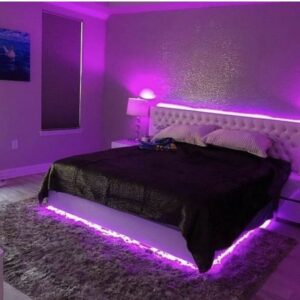Understanding LED Lights
How Do LED Lights Work?
Modern lighting technology, LED (Light Emitting Diode), produces light through electroluminescence, unlike traditional incandescent bulbs which generate light by heating a filament. This method is significantly more energy-efficient and operates at cooler temperatures, reducing the risk of overheating. Despite these advantages, it is essential to remain aware of potential safety concerns related to LED lights fires.

One of the main selling points of LED lights is their energy efficiency. They consume approximately 80% less energy in comparison to standard incandescent bulbs and can be more than 25 times longer-lasting. Along with that results in lower electricity bills and fewer replacements thus appealing to people who want to save some cash while decreasing their environmental footprint.
From kitchens and bathrooms to outdoor landscapes, LED lights are used in a variety of settings. However, widespread adoption has also led to an increase in potential risks, especially when LED lights are not correctly manufactured, installed or used.
The Fire Hazard Concern
-
Overheating Issues
While LED bulbs have a lower temperature compared to the incandescent types nevertheless, they can also experience overheating. The overheating of LED lights comes from poor ventilation, the use of low-quality components and improper installation. This means that in the event that somebody places it close to inflammable materials, it can be a source of fire danger.
2.Poor Quality Manufacturing
Not all LED lamps are comparable. Poor production leads to low-quality materials that are inadequate in security requirements. Inferior products tend to overheat easily, have electrical failures and can sometimes ignite fires too. Hence, it is always safer to choose well known brands with acceptable certifications.
3.Installation Issues
Improper installation is yet another major reason which leads to fire hazards from LED lights. If the manufacturers’ specifications are not adhered to while installing LED lights they may overheat and become potential causes of fires. These includes wrong wiring, insufficient ventilation as well as incorrect dimmer switches.
Unfortunately, there have been several incidents where LED lights have led to fires. In one notable case, Best Lighting Products has recalled their LED High Bay light fixtures following reports of fires due to faulty plastic pins. Similarly Good Earth Rechargeable Integrated Lights were recalled after reports of overheating and ignition, with one death reported.
Fire Damaged Homes
When LED lights cause a fire, the damage can be extensive. Homes affected by such incidents may become unsellable or require significant remodeling. Homeowners must decide whether to remodel the fire-damaged home or sell it as-is. Services like fire cash buyers can help homeowners sell their fire-damaged properties quickly, providing a viable solution in such unfortunate events.
Regulatory and Safety Measures
Various safety standards, set by organizations like Underwriters Laboratories (UL) and the International Electrotechnical Commission (IEC), are crucial in regulating the quality and safety of LED lights. These standards ensure products undergo rigorous testing before reaching consumers. Certification marks such as UL, CE, and RoHS serve as indicators of compliance with these safety standards, helping consumers identify safe and certified products.
Moreover, governments worldwide are implementing regulations covering manufacturing, installation, and consumer safety aspects for LED lights. Staying informed about these regulations and recognizing certification marks can significantly enhance consumer safety and prevent incidents related to faulty LED lighting products.
Final Thoughts
LED lights have many benefits such as being energy-efficient and versatile, but they also come with fire risks that must not be ignored. In order to enjoy these benefits safely, it is important to know the risks involved and take safety precautions. One way of raising awareness on these dangers is by educating our families, friends and community at large about them. For any concerns regarding safety, it is wise to consult an electrician who can ensure that your lighting installation is safe as well as energy-efficient. While the potential for fire is quite low, it’s necessary to select high-quality products, adhere to proper installation guidelines and comply with up-to-date safety regulations in order to effectively mitigate any risks. You can light up your house responsibly and enjoy all the advantages of LED lighting.
Previous